Lined up against one of the conference room walls were (5) large,personalized, plastic boxes. Inside was our custom Sparco LCI / Tasman firesuits, exact replicas of Tony Kaanan's. Also enclosed were personalized Bellhelmets, headsocks, Tasman logo polo shirts and hats, a very cool pair of prorace car driver sun glasses, binoculars, high quality framable prints of the1998 LCI Champ Car, and an envelope generously stuffed with some walkingaround money. With everyone happy with their fire suits, and grateful for theunexpected gifts bestowed upon us by Tasman, we headed to the nerve center ofthe operation for a shop tour, seat fittings and a crash instruction course byChief Engineer, Diane Holl on how to drive an 800 hp, 1500 lb. Champ Car.
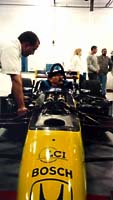 |
| Seat fitting in Tasman shop |
While the others were being fitted I explored every detail of the car. Theside pods and engine cover were off so I had free access to ingest everyexplicit detail of this spectacular machine. There is no dirt, grease, oil,fuel; dirty shop rags or paper towels anywhere in Tasman's facility. Everytool is cleaned and put away after each use and the glowing engine bay I wasviewing reflected that philosophy. It was impeccably clean. I visuallydevoured large chunks of alloy and carbon fiber while gently running myfingertips across the cast Honda logo.
In another area of the shop an engineer was working on aerodynamic changes tothe Tasman wind tunnel car. A miniaturized version in every detail to theChamp Car I had just exited. "We're up second on the schedule next week inIndianapolis right after BAR's F1 car," the engineer said, referring to thewind tunnel facility located in that city. "I'll be happy to answer anyquestions, but there is absolutely no photos allowed in this area," he saidwhile looking at the 35mm camera dangling from my wrist. He explained how thecar is held stationary with only the aluminum wheels moving on the high-tension conveyor belt of the wind tunnel testing machine. "This car is wiredwith sensors in every conceivable area and every piece of date is continuouslydownloaded into the computer during the wind tunnel test," he said whileholding a 3" diameter socket with dozens of tiny connecting ports for me toview. "Impressive," was the only thing I could think while walking awayshaking my head unsure why I couldn't formulate more questions to ask theresponsive engineer. I was in sensory overload surrounded by all of the racecar tubs in various stages of assembly. I paused briefly to gaze upon an8-piston Brembo brake caliper mounted on a platter size vented brake disc madeof carbon fiber. "When you stomp on these babies tomorrow at triple digitspeeds your eye balls are going to feel like they're coming out of theirsockets," the technician joked with a big grin on his face. "Just don't lock'em up and flat spot the tires is my only advise." I thanked him for thewarning, again walking away shaking my head, which now was on the verge ofdizziness.
Diane Holl is the only female Chief Engineer in CART, or in any other premierracing series that I know. She's an attractive, blond, 30-something, womanwith a spirituous British accent and the intelligence of an automotiveEinstein. She ultimately makes the final call on all race day set-ups. Dianegathered the five would-be drivers around the Champ Car for our drivinginstruction briefing. In an effort to reassure our confidence, Diane calmlytold us that driving this racing car was not much different than driving ourpersonal road cars. "Oh, sure," I mumbled to myself. She had us focus on thevery stiff, short clutch release. The sequential gear change lever. Theamber-to-red light panel visible through the steering wheel used to alert usof gear change points. We were to concentrate only on the fundamentalfeatures in the cockpit and not worry about some of the more exotic thingslike roll bar adjustment controls, turbo boost increase buttons, and a bunchof other neat looking stuff. We would be wired for sound and Diane would betalking to us while we were on the track, offering suggestions on the propertrack line, braking and turn-in points, keeping the car balanced andfeathering the extremely sensitive accelerator pedal to control wheel spin.The more vividly Diane described the sensations we could expect while drivingthe $1 million Tasman Champ Car the higher my pulse rate soared in expectancyof the following days test drive.
When you've leaped forward two time zones on a journey to Columbus, 7:00amSaturday morning rolls around pretty early. However, it really didn't mattermuch to me since I had spent more time fantasizing about driving the racingcar than actually sleeping the preceding night. Everyone met in the lobby ofour hotel for a Continental breakfast in preparation for the 45-mile drive tothe Transportation Research Center (TRC) in East Liberty, OH. TRC is anextremely high security vehicle testing facility used primarily by Honda MotorCompany who has an astonishingly large manufacturing plant just minutes away.Its perimeter is a 71/2-mile, 4 lane, 36 degree banked oval track.We would be using a 45-acre slab of ultra-smoothasphalt called the Vehicle Dynamics Area located inside the huge oval. Ahearty crew of Tasman employees was up several hours before me setting uphundreds of orange cones that outlined the 7-turn, almost 4000-foot roadcourse we would be using. We had been given a detailed diagram of the roadcourse on Friday and I had memorized it by heart that night. Only oneproblem, I made the assumption we would run the course clockwise. Wrong!
I hate to think of myself as a skeptic, but on the ride to TRC Scott Lewis andI speculated the driving event may not meet the high expectation both of ushad put on it. Our logic? The 1998 CART finale was the previous weekend.It's a long drive from Fontana to Columbus. The Tasman team and crew had tobe worn out from the grueling, 8-month schedule. Since it's just a handful ofnovice contest winners they'll probably just truck the cars out with a coupleof guys and let us have a go of it. If we can drive the car, fine. If wecan't, tough luck.
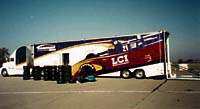 |
| Tasman headquarter with new rubber |
Then finally, asif orchestrated on a predetermined command, the glistening LCI Champ Car waseased from its berth atop the transporter and slowly lowered to the ground.All eyes following its every move. The crew gingerly rolled the car into anearby staging garage to be warmed. Quilted blankets covered its massivewings. The engine cover was removed and several of the crew went to workreadying the Honda power plant for ignition. Although I was sipping steaminghot coffee to shake off the chill of the late Fall Midwestern morning, I knewmy internal trembling was caused more by my anticipation of the moment thestarter motor would be inserted just under the rear wing and the gloriousengine would soon bark to life. When the starter motor was coupled, engaged,and the whirling sound commenced, if was but moments before the powerfulracing engine came to life. Sputtering at first, then blasting into fullglory. Its beginning deep growl pitched higher and higher as the mechanicstabbed at the throttle linkage. I could indeed feel the ground shake underthe thin soles of my driving shoes as the thunderous exhaust note reverberatedoff the galvanized steel walls of the building we were within. A huge, ear-to-ear grin overtook my face, which remained present for the next 8 hours,while I relished in the fantastic sounds resonating from the racing car I soonwould be driving.
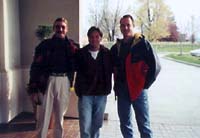 |
| Tim Youart (L), Eric Lang (M), Scott Lewis (R) |
Since I wasn't scheduled to drive the Champ Car until afternoon, I wasenjoying a leisurely morning visiting with many of the Tasman guys andlearning as much as possible about the car and pit operation. To Eric Lang'sthrilling surprise, Steve Horne gave him the task of bringing the fluidtemperatures up and putting some heat in the Champ Car's massive Firestonetires. The crew rolled the car out of the garage and staged it in the pitarea. The Tasman guys swarmed the car; each focused on their own chore. Igot as close as possible to hear the driving and operating instructions we hadheard the previous day, only this time there was an intense sense of urgency.The crew rolls the car back and forth to ensure the gearbox is in neutral.The electric starter is inserted and engaged in the rear of the engine whileEric flips the ignition switch to the On position and confirms he is ready byraising one hand. The starter rooter whines briefly before the engine firesand Eric stabs at the throttle repeatedly feeding the high strung engine largegulps of racing fuel. I watch the light panel sequence up and down fromyellow to red to yellow as he revs the motor. Eric's been instructed to holdthe throttle position steady at the 3rd yellow light, representing 6000 rpms,and pull the sequential shift level back into first gear. Four crewmemberspush the car off and at his discretion he's to release the 2" clutch traveland simultaneously accelerate the car. We watch with anxiety as Eric stalledit. With the car now dead the silence was deafening. In a good-natured wayeveryone chortles at a seasoned pro driver stalling the car, but in my mind Iwas thinking, "if he can't get it launched how am I going to do it?" The crewrolled the car back into the staging area and the whole process began again.This time Eric revved the engine deep into the red light zone beforedisengaging the clutch and the result was spectacular as he ignited thegigantic rear tires into a billow of blue-white smoke. Everyone applauded hissensational exit and we were glued to the brilliant car carving its waythrough the temporary road course. I watched Eric's every move, listeningintently to what gear he was changing into before, through, and after eachturn. In the two straights I focused on which of the six gears he couldachieve before stomping on those mammoth brakes in preparation for the nextupcoming corner. I devoured every movement, every sound with an astute levelof awareness. I was standing next to Diane Holl who was talking to Ericthrough her headset and after a dozen or so laps she called him back into thepit area. Eric emerged from the cockpit with a permanent grin stuck on hisface. After all his years of racing this too was his first experience in aChamp Car.
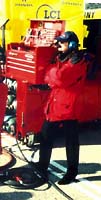 |
| Diane Holl's sweet voice in my ear |
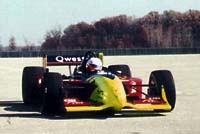 |
| First hands-on experience |
The first thing that had to be overcome was my childish fascinationwith playing with the sequential gearbox. Early on I just couldn't resistshifting. It didn't matter if I was short shifting or not, I just couldn'tcontest my desire to row up and down through the gears while listening to thefabulous mechanical sounds which accompanied the gear changes. Once I hadovercome this urge I settled into a lapping rhythm that proved to besuccessful in bettering my lapping times as reflected in the very difficult toread date acquisition screen. Exiting the last 90 degree, left hand turn in1st gear, the course opened up onto a long straight with a gradual left handsweeper which was defined as turn-1. Squeezing on the power just enough tofeel the rear end slide out a little, and running the light sequence throughits full range, I would be in 3rd gear at the entrance of turn-1. Brakingwasn't required, only a slight lift off the power. The Champ car turned in asif it were grounded to a rail. "Point and squirt," I thought to myself with asmile. After the slight lift, back on the power again momentarily beforestomping on the 8-piston, Brembo binders while simultaneously pushing theshift lever up once engaging 2nd. The next three turns were 90 degree leftand right followed by a hairpin left which opened up onto a long straight.The first two turns of this left, right sequence were most effective in 2ndgear with 1st used to exit the hairpin. The sensational responsiveness of thepower range, coupled to instantaneous braking, scrubbed off whatever speed youdesired prior to corner turn-in.
I found myself putting as much power down aspossible before braking at the latest feasible moment. Threshold braking atturn-in, then hard on the power again. It may not have been the fastest waythrough this 3-turn sequence, but the wheel spin fishtail exits made forexciting spectator viewing I later learned. Something interesting dawned onme after the first 4 or 5 laps. I had unknowingly resorted to left footbraking, a throw back to the week I had spent at Jim Hall's shifter kartschool. With no need to clutch, it just seemed appropriate to alternate myleft foot between the dead pedal and the brake. Exiting the hairpin in 1stgear onto the longest straight provided the chance to shift four more times,using 5thgear briefly before standing the car on its nose and starting thenext lap. This was the fastest part of the course and I could barely reachtriple digit speeds before the braking zone. The wonderful experience ofdriving the Champ Car wasn't so much achieving top end speeds, but maneuveringthe car around the short, tight, 4000 ft., 7-turn road course as fast andefficiently as possible. The enjoyment came from the colossal accelerationand braking responsiveness. Holding the power down that extra 10th of asecond longer than the previous lap. Pushing further into the braking zoneuntil the front tires just begin to lockup and a puff of smoke alerts you toease off the pedal if you're going to make the turn-in verses snowplowingstraight through the corner. Diane called me back into the pit area at thecompletion of the lap. "My test couldn't possibly be over," I worried whilerolling into the pit while turning the ignition switch to the "Off" position.The crew swarmed the car again as I listened to Diane explaining that Mr.Horne had advised the crew to turn the revs up a notch. Initially, the5-light sequence represented 2,000 rpm's per light for a maximum rev limiterof 10,000 rpm's at the 5th red light, substantially lower than the 14,500rpm's Tony Kaanan uses during the race season.
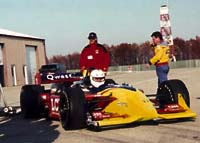 |
| Ready for increased power |
I can't overemphasize how light andsensitive the power pedal is in a Champ Car, and it was never so evident thanwhen I looped it in my enthusiasm to get the power down quickly at the exit ofthe first of those three turns. Fortunately, I depressed the clutch in timeto keep it running, pushed the shift lever up into 1st, and piled on enoughpower to launch the car back onto the course again. I treated the right handpedal with more respect from that point and my lap times improved accordinglyat the expense of somewhat less flamboyant corner exits. Sensing my seat timewas coming to an end, I concentrated on the fundamentals of driving thecourse. I positioned the car correctly at the entrance of each corner toachieve a late apex. I kept the engine in the upper rpm range confirmed bythe constantly lit red lights in the shift panel, and I resisted the urge toupshift. I learned to apply firm and constant pressure to the brake pedal inlieu of stomping down hard. The data acquisition screen confirmed fasteraverage lap speeds and lower ET's were best achieved by running the car in agear no lower than 2nd in the corners and no higher than 4th in the straights.The added power allowed me to exit the slowest corner in 2nd gear with littlewheel spin and I had run enough consecutive laps I was comfortable with thesequential gearbox operation, both up and downshifting. Diane had let me runfor quite some time without any conversation, allowing me to concentrate ondriving the car undisturbed. When her soothing voice finally entered myhelmet I knew my stint was up. "Bring her in, Tim. Well done".
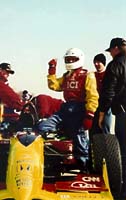 |
| Thumbs Up! |
Shortly after, Diane Holl presented me with a personalized Engineering Reportcontaining several graphs which reflected speed, lateral g-forces, gearselections, steering and braking input and a summary of each of my lap timesby sector. Whereas most of my lap times were consistently in the 30-31 secondrange, my best was 29.75 sec. I was pleased.
Throughout the rest of the morning and early afternoon the rest of the contestwinners drove the LCI Champ Car with mixed results, but similar gratification.A tire changing contest for the winners was scrubbed in exchange for somethingwhich had never been done before in motorsports at this level. Since thefacility had been contracted for the entire day, with the last test drive tobe completed by no later than 4:00 p.m., Steve Horne gave each of hiscrewmembers a 5-lap stint in the Champ car.
I have never witnessed such sheervivacity as each crewmember was told to suit-up by their team owner. Someactually kicked up their heels in route to putting on their fire suits whilescrambling to find driving shoes and helmets to fit. One crewmember said, "13long years I've worked in Indy and Champ Car racing and I've never driven acar once. This is incredible!" Everyone enjoyed watching each other jump inthe car and go through the same staging routine I had done earlier. Manykilled it just as I had done on my first attempt to launch the car, otherssmoked it out of the pit area like a veteran. Everyone emerged with a hugesmile on their face, they too stumped for words to summarize their feelings.It was a marvelous gesture by a gracious team owner to give each of hiscommitted team members a turn at the wheel of the car they had worked so hardto make competitive throughout the season, and it was certainly appreciated byeveryone who drove that day.
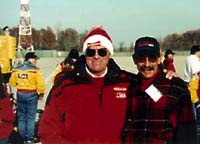 |
| Author with "the Boss," Steve Horne |
It had been a phenomenal weekend. I had been running on racing adrenaline foralmost 48 consecutive hours. I felt content that I had made the most of theopportunities that were offered as a result of being picked as one of theUltimateRide contest winners. Perhaps I had forced myself inside the Tasmancircle further than I should. But you only get one shot at rubbing shoulderswith the owner of notable Champ Car team and I wanted to attain as muchknowledge and information as possible to pass along to my SPEEDCENTER cohorts.
FOOTNOTE: Sunday was a backup day if the weather turned out uncooperativeSaturday. There wasn't anything planned except early evening flights back toreality. Scott Lewis and I searched out an address also located in thesuburbs of Columbus, Ohio. We found a sizable building painted completelyblack except for a strip of red trim around the top perimeter. The buildingwas surrounded by a lawn still green and cradled in a grove of hardwood treescolored with Fall. The only windows were tinted very dark and even peering inthrough cupped palms around our eyes we could see but mere glimpses of thenumerous mementos of victory. There was no guard or security, not even apersonal vehicle sitting in the new asphalt driveway. The grounds wereimpeccable. We spotted a gate and an 8 foot chain link fence enclosing theparking area. Three large transporters still attached to their tractors wereparked in exact proportion to one another. The sky was overcast and the airwas still. There was only a very small sign that marked the location and itread ... RAHAL
Tim H. Youart
Albuquerque, New Mexico
photos © 1998 Tim H. Youart